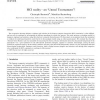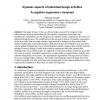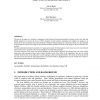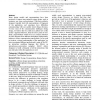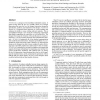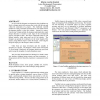HCI
2009
14 years 5 days ago
2009
Recent work demonstrates the potential for extracting patterns from users' behavior as detected by sensors. Since there is currently no generalized framework for reasoning abo...
CORR
1998
Springer
14 years 2 months ago
1998
Springer
Technology designers often strive to design systems that are flexible enough to be used in a wide range of situations. Software engineers, in particular, are trained to seek gener...
IJMMS
2007
14 years 2 months ago
2007
The cooperation between designers, engineers and scientists in the human–computer interaction (HCI) community is often difficult, and can only be explained by investigating the...
CORR
2007
Springer
14 years 2 months ago
2007
Springer
This paper focuses on the use of knowledge possessed by designers. Data collection was based on observations (by the cognitive ergonomics researcher) and simultaneous verbalisation...
IADIS
2004
14 years 3 months ago
2004
The aim of this paper is to conduct a comparative study between liberal and prescriptive cultures (in this case Arab and British audiences) to extract the views of Web designers i...
ERSA
2008
14 years 3 months ago
2008
Partial reconfiguration (PR) reveals many opportunities for integration into FPGA design for potential system optimizations such as reduced area, increased performance, and increa...
CHI
2005
ACM
14 years 4 months ago
2005
ACM
Many design models and representations have been proposed to support user-centered system design, such as scenarios, use cases, and prototypes. With these artifacts, designers typ...
DAC
1999
ACM
14 years 6 months ago
1999
ACM
IPCHINOOK is a design tool for distributed embedded systems. It gains leverage from the use of a carefully chosen set of design ions that raise the level of designer interaction d...
CANDC
1999
ACM
14 years 6 months ago
1999
ACM
The goal of our research is to develop computer systems that support designers’ collective creativity; such systems support individual creative aspects in design through the use...
ACMDIS
2000
ACM
14 years 6 months ago
2000
ACM
In real world development environments where deadlines are fixed, a designer must craft a process that works with the team and within the constraints of a project. The traditional...

